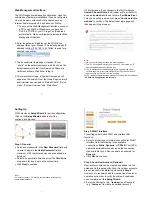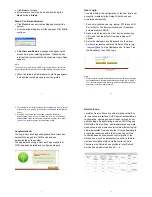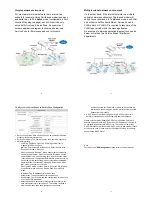
13
Simple network environment
For most simple internal network, there are just two
subnets for example. Using Port-Based model is an easy
and better way. In Port-Based mode (configurable in Port
Location Mapping tab page), each LAN port can only
serve traffic from one Service Zone. An example of
network application diagram is shown as below: one
Service Zone for Employees and one for Guests.
14
Multiple subnet network environment
On the other hand, if the internal network is a multiple
subnets network environment, Tag-Based model will
satisfy to your demands. In Tag-Based mode, each LAN
port will serve traffics from different Service Zones; a
VLAN switch or VLAN AP is required to take care of the
VLAN tags carried within the message frames.
An example of network application diagram is shown as
below: more than two Service Zones for different
departments.
15
Go to
System => Service Zones => Service Zone Configuration
Service Zone Status: Each service zone can be enabled or disabled
except for the default service zone.
Service Zone Name: The name of service zone could be input here.
Network
Interface:
o
VLAN Tag (Tag Base Only): The VLAN tag number that is
mapped to the Service Zone.
o
Inter LAN Port Isolation (Port Base Only): Select Enable, Auth
Required or Disable. When the
o
When the option is “Enabled”, clients under different LAN ports
cannot ping each other. When the option is “Disabled”, clients
under different LAN ports can ping each other. When the option
is “Auth Required”, clients under different LAN ports cannot ping
each other unless both of them has successfully authenticated.
o
Operation Mode: Contains NAT mode and Router mode. When
NAT mode is chosen, service zone
o
When the NAT mode is chosen, Service Zone runs in NAT mode.
When Router mode is chosen, Service Zone runs in Router
mode.
o
IP Address: The IP Address of this service zone.
o
Subnet Mask: The subnet Mask of this service zone.
o
IPv6 Settings: The IPv6 Address and configuration of this service
zone (when IPv6 is enabled).
o
Network Alias List: Administrator may optionally set many alias
network segments for a service zone. This feature can allow a
single service zone to be seen as many service zones.
16
Additional to hide the IP address of a Service Zone’s network
interface and to some degree, provide protection from possible
attacks from LAN clients.
DHCP Server: From the drop down menu, DHCP server for this
particular service zone may be Disabled, Enabled or Relayed.
Please note that when “Enable DHCP Relay” is enabled, fill in the IP
address of the external DHCP Server, and the IP address of clients will
be assigned by an external DHCP server. The system will only relay
DHCP information from the external DHCP server to downstream clients
of this service zone. Please note that Controller should be in the same
subnet as the DHCP server.
Note:
For the set up of
AP Management
, please refer to the User Manual.






















